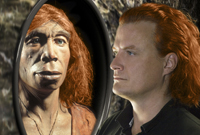The Neanderthal in your Genes
Interview with
Diana - Also in the news this week, a new genetic analysis of nearly 2,000 people from all over the globe suggests that our ancestors interbred with Neanderthals over at least two different periods. We're joined by Professor Jeffrey Long, leader of the team at the University of New Mexico, who have reported on this finding.
Jeffrey - Good morning. What we looked at were genotypes, genetic typings, from about 600 places throughout the genome from people from about a hundred different populations throughout the world.
Diana - And what did you look at in their DNA?
 Jeffrey - Well we looked at subtle variations that are sometimes called microsatellite loci or short tandem repeat loci. And these are just regions of DNA. Typically, they don't code for any products. They're sometimes called 'junk DNA' where people have small differences in the amount of DNA that they have. These are the kinds of genetic markers that are used in DNA fingerprinting and forensics and parentage testing, and a lot of routine tests these days.
Jeffrey - Well we looked at subtle variations that are sometimes called microsatellite loci or short tandem repeat loci. And these are just regions of DNA. Typically, they don't code for any products. They're sometimes called 'junk DNA' where people have small differences in the amount of DNA that they have. These are the kinds of genetic markers that are used in DNA fingerprinting and forensics and parentage testing, and a lot of routine tests these days.
Diana - So, do we know if the microsatellites actually do anything?
Jeffrey - There are a few circumstances where they do. Most notably, there's a microsatellite type of locus in the gene that is important for Huntington's disease. But there are only a couple of dozen of those where they're actually in genes that do anything. There are thousands of them throughout the genome and most of them - the vast majority of them - don't do anything.
Diana - So when you looked at these microsatellites, what sorts of genetic variations did you see?
Jeffrey - What we saw when we looked at these microsatellites is that people typically, and this is standard for genetics, have different amounts of DNA in each of these locations and they have more or less high mutation rates, by genetic standards at least. And because of that we have all of these variations and you get clustering of patterns throughout the world. And that's what we started looking at in this study. We were interested in a model that's called the serial founder effects model and with serial founder effects, what we've postulated and other groups have postulated, is that you have that original population in Africa and then a small group left Africa and populated Europe and Asia, and eventually Asia and the Oceania as well. We were interested in studying that effect.
Diana - So how did you find these clusters of variation varied geographically as well? Did they tie-in with these models?
Jeffrey - Well for the most part, what we found was that what you find outside of Africa is a subset of what you find in Africa. What you find in any region outside of Africa, say Asia, is a subset of all Africa and the like. But the thing that surprised us was that in the out of Africa group, there was a little bit more variation than the model could account for. So we found variation in Eurasians, people in the Pacific Islands, and the Americas that couldn't be accounted for by the out of Africa migration.
Diana - So you think this genetic information is coming from somewhere else?
Jeffrey - Yes. So we had to look at possibilities of where it could come from and what could account for it. Now, one of the things that our colleagues suggested to us is that it might be just by what we call gene flow which is sort of the 'boy marries girl next door' effect that goes on throughout the world where people in these different regions do occasionally mate with each other. But that couldn't account for the effect, and in retrospect, it really could not have because that sort of gene flow just spreads things around, it doesn't create or destroy variation itself. And then we eventually came to a conclusion of is it would have had to have been from, essentially, hominids that were like people that were existing in this area or at least we think that's the best explanation at this time.
Diana - So one possibility would be Neanderthals. And if it was, what does that mean for human populations?
Jeffrey - Neanderthals are certainly a possibility but there were many different sorts of archaic people around the world before we got the modern Homo sapiens evolving. But the main implication of this is that for the last one or two decades, we really believed that once Homo sapiens evolved, they replaced all of these people around the world and didn't mate with them or incorporate any of their genes. It was a very rigid speciation event. Now what this is telling us is that our closest relatives were pretty much similar to us and it was possible to interbreed and that perhaps the speciation event wasn't quite as rigid as we thought in the past.
Diana - Indeed, well thanks very much, Jeffrey. That's Professor Jeffrey Long on the genetic evidence that most people alive today carry a little bit of Neanderthal or potentially another early human species in their genes. This work was presented at the recent meeting of the American Association of Physical Anthropologists' Annual Meeting in Albuquerque, New Mexico.










Comments
Add a comment